EduStream Project Charter: ICT508 Project Management & Planning EdMI
VerifiedAdded on 2023/04/07
|6
|1398
|328
Project
AI Summary
This document presents a standard project charter template for the EduStream project, an initiative by EdMedia International Pty Ltd (EdMI) to develop an educational website. The project aims to address the evolving needs of students for flexible access to educational content. The charter includes a stakeholder analysis, SWOT analysis, preliminary financial analysis, and an overview of project planning, including key milestones and deliverables. It defines the project's success criteria, approach, and roles and responsibilities matrix. The project seeks to deliver a high-quality, engaging video content provider website with high encryption systems and a chat assistant to meet the expectations of students. This document along with other solved assignments are available on Desklib.
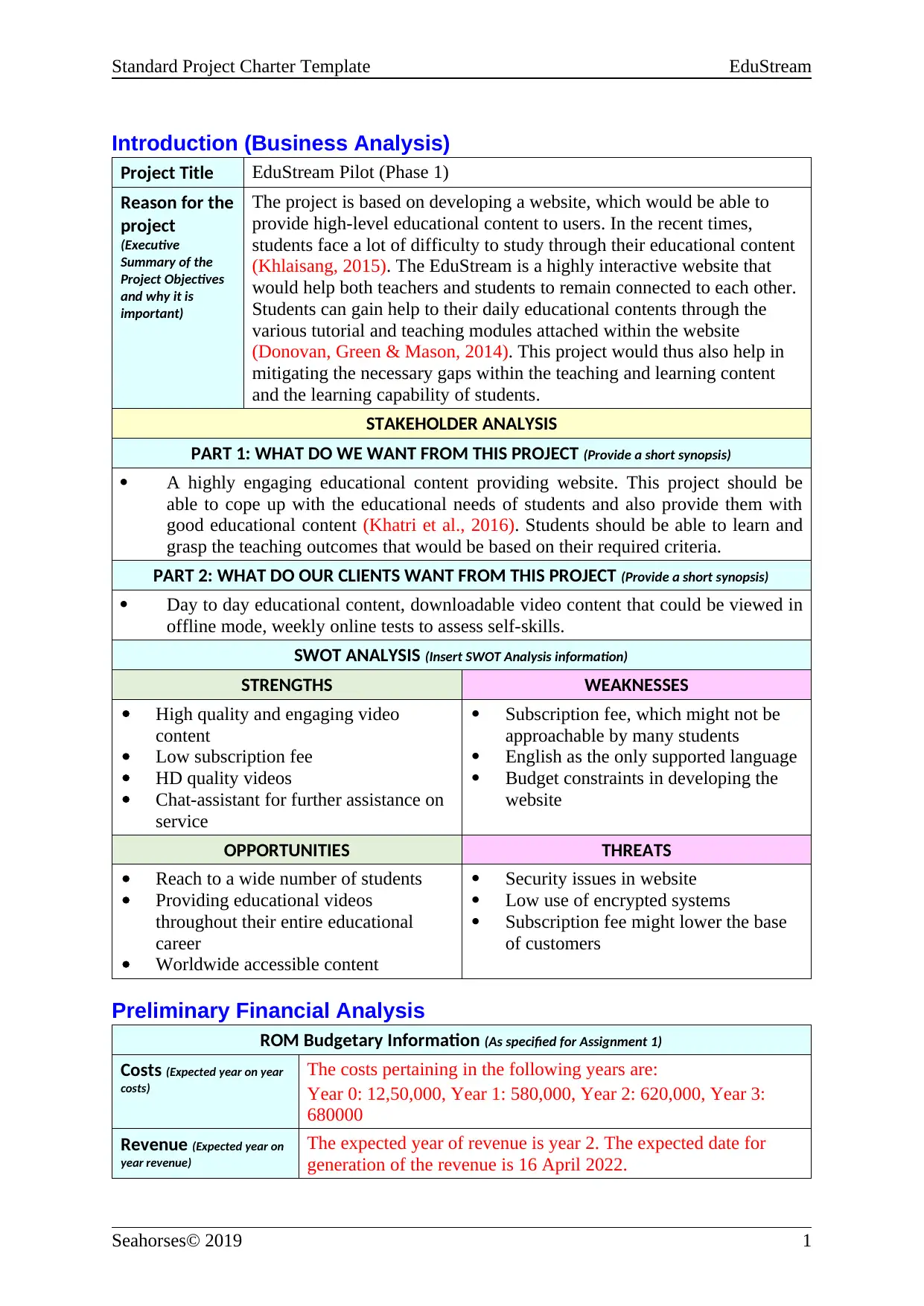
Standard Project Charter Template EduStream
Introduction (Business Analysis)
Project Title EduStream Pilot (Phase 1)
Reason for the
project
(Executive
Summary of the
Project Objectives
and why it is
important)
The project is based on developing a website, which would be able to
provide high-level educational content to users. In the recent times,
students face a lot of difficulty to study through their educational content
(Khlaisang, 2015). The EduStream is a highly interactive website that
would help both teachers and students to remain connected to each other.
Students can gain help to their daily educational contents through the
various tutorial and teaching modules attached within the website
(Donovan, Green & Mason, 2014). This project would thus also help in
mitigating the necessary gaps within the teaching and learning content
and the learning capability of students.
STAKEHOLDER ANALYSIS
PART 1: WHAT DO WE WANT FROM THIS PROJECT (Provide a short synopsis)
A highly engaging educational content providing website. This project should be
able to cope up with the educational needs of students and also provide them with
good educational content (Khatri et al., 2016). Students should be able to learn and
grasp the teaching outcomes that would be based on their required criteria.
PART 2: WHAT DO OUR CLIENTS WANT FROM THIS PROJECT (Provide a short synopsis)
Day to day educational content, downloadable video content that could be viewed in
offline mode, weekly online tests to assess self-skills.
SWOT ANALYSIS (Insert SWOT Analysis information)
STRENGTHS WEAKNESSES
High quality and engaging video
content
Low subscription fee
HD quality videos
Chat-assistant for further assistance on
service
Subscription fee, which might not be
approachable by many students
English as the only supported language
Budget constraints in developing the
website
OPPORTUNITIES THREATS
Reach to a wide number of students
Providing educational videos
throughout their entire educational
career
Worldwide accessible content
Security issues in website
Low use of encrypted systems
Subscription fee might lower the base
of customers
Preliminary Financial Analysis
ROM Budgetary Information (As specified for Assignment 1)
Costs (Expected year on year
costs)
The costs pertaining in the following years are:
Year 0: 12,50,000, Year 1: 580,000, Year 2: 620,000, Year 3:
680000
Revenue (Expected year on
year revenue)
The expected year of revenue is year 2. The expected date for
generation of the revenue is 16 April 2022.
Seahorses© 2019 1
Introduction (Business Analysis)
Project Title EduStream Pilot (Phase 1)
Reason for the
project
(Executive
Summary of the
Project Objectives
and why it is
important)
The project is based on developing a website, which would be able to
provide high-level educational content to users. In the recent times,
students face a lot of difficulty to study through their educational content
(Khlaisang, 2015). The EduStream is a highly interactive website that
would help both teachers and students to remain connected to each other.
Students can gain help to their daily educational contents through the
various tutorial and teaching modules attached within the website
(Donovan, Green & Mason, 2014). This project would thus also help in
mitigating the necessary gaps within the teaching and learning content
and the learning capability of students.
STAKEHOLDER ANALYSIS
PART 1: WHAT DO WE WANT FROM THIS PROJECT (Provide a short synopsis)
A highly engaging educational content providing website. This project should be
able to cope up with the educational needs of students and also provide them with
good educational content (Khatri et al., 2016). Students should be able to learn and
grasp the teaching outcomes that would be based on their required criteria.
PART 2: WHAT DO OUR CLIENTS WANT FROM THIS PROJECT (Provide a short synopsis)
Day to day educational content, downloadable video content that could be viewed in
offline mode, weekly online tests to assess self-skills.
SWOT ANALYSIS (Insert SWOT Analysis information)
STRENGTHS WEAKNESSES
High quality and engaging video
content
Low subscription fee
HD quality videos
Chat-assistant for further assistance on
service
Subscription fee, which might not be
approachable by many students
English as the only supported language
Budget constraints in developing the
website
OPPORTUNITIES THREATS
Reach to a wide number of students
Providing educational videos
throughout their entire educational
career
Worldwide accessible content
Security issues in website
Low use of encrypted systems
Subscription fee might lower the base
of customers
Preliminary Financial Analysis
ROM Budgetary Information (As specified for Assignment 1)
Costs (Expected year on year
costs)
The costs pertaining in the following years are:
Year 0: 12,50,000, Year 1: 580,000, Year 2: 620,000, Year 3:
680000
Revenue (Expected year on
year revenue)
The expected year of revenue is year 2. The expected date for
generation of the revenue is 16 April 2022.
Seahorses© 2019 1
Paraphrase This Document
Need a fresh take? Get an instant paraphrase of this document with our AI Paraphraser
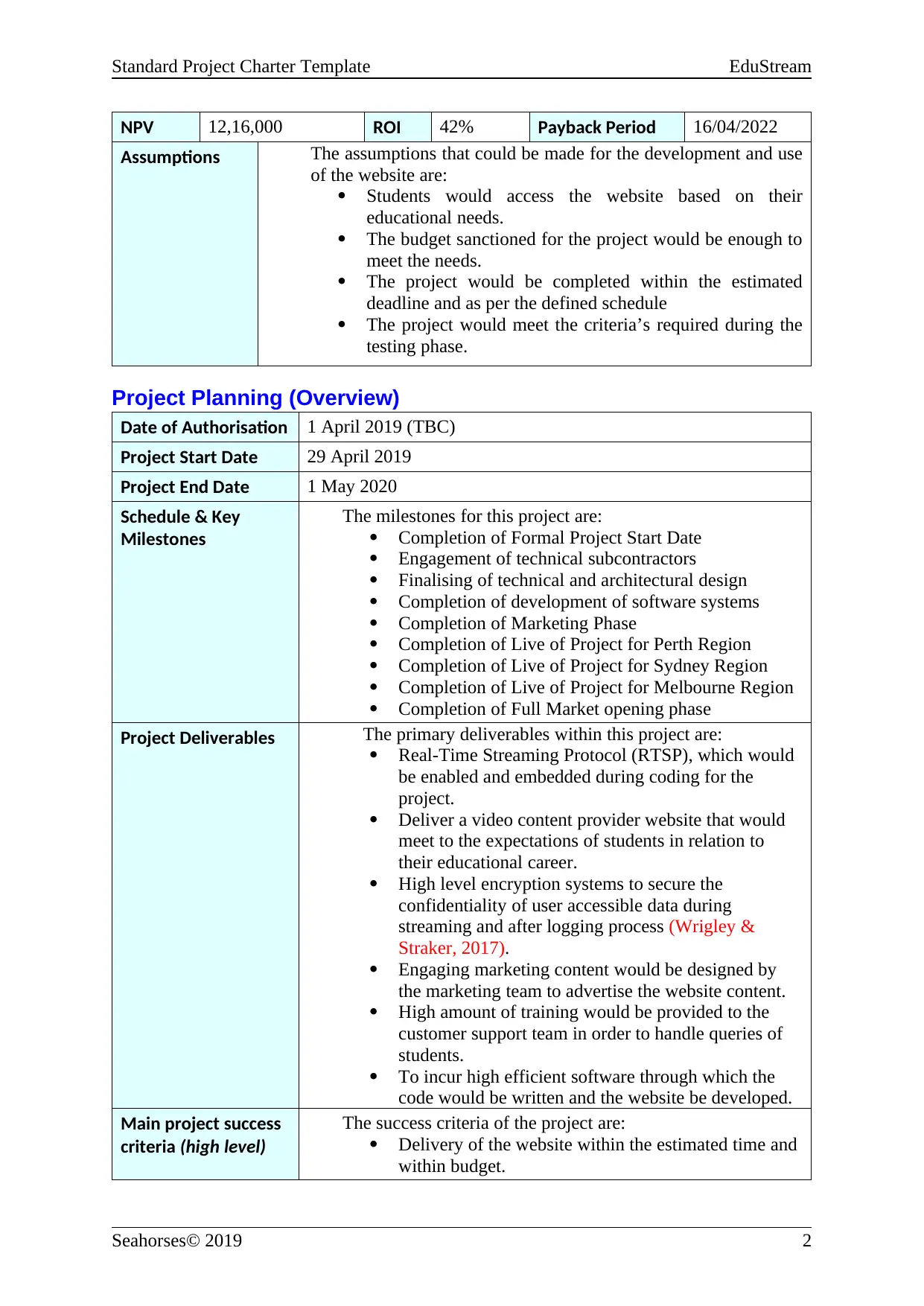
Standard Project Charter Template EduStream
NPV 12,16,000 ROI 42% Payback Period 16/04/2022
Assumptions The assumptions that could be made for the development and use
of the website are:
Students would access the website based on their
educational needs.
The budget sanctioned for the project would be enough to
meet the needs.
The project would be completed within the estimated
deadline and as per the defined schedule
The project would meet the criteria’s required during the
testing phase.
Project Planning (Overview)
Date of Authorisation 1 April 2019 (TBC)
Project Start Date 29 April 2019
Project End Date 1 May 2020
Schedule & Key
Milestones
The milestones for this project are:
Completion of Formal Project Start Date
Engagement of technical subcontractors
Finalising of technical and architectural design
Completion of development of software systems
Completion of Marketing Phase
Completion of Live of Project for Perth Region
Completion of Live of Project for Sydney Region
Completion of Live of Project for Melbourne Region
Completion of Full Market opening phase
Project Deliverables The primary deliverables within this project are:
Real-Time Streaming Protocol (RTSP), which would
be enabled and embedded during coding for the
project.
Deliver a video content provider website that would
meet to the expectations of students in relation to
their educational career.
High level encryption systems to secure the
confidentiality of user accessible data during
streaming and after logging process (Wrigley &
Straker, 2017).
Engaging marketing content would be designed by
the marketing team to advertise the website content.
High amount of training would be provided to the
customer support team in order to handle queries of
students.
To incur high efficient software through which the
code would be written and the website be developed.
Main project success
criteria (high level)
The success criteria of the project are:
Delivery of the website within the estimated time and
within budget.
Seahorses© 2019 2
NPV 12,16,000 ROI 42% Payback Period 16/04/2022
Assumptions The assumptions that could be made for the development and use
of the website are:
Students would access the website based on their
educational needs.
The budget sanctioned for the project would be enough to
meet the needs.
The project would be completed within the estimated
deadline and as per the defined schedule
The project would meet the criteria’s required during the
testing phase.
Project Planning (Overview)
Date of Authorisation 1 April 2019 (TBC)
Project Start Date 29 April 2019
Project End Date 1 May 2020
Schedule & Key
Milestones
The milestones for this project are:
Completion of Formal Project Start Date
Engagement of technical subcontractors
Finalising of technical and architectural design
Completion of development of software systems
Completion of Marketing Phase
Completion of Live of Project for Perth Region
Completion of Live of Project for Sydney Region
Completion of Live of Project for Melbourne Region
Completion of Full Market opening phase
Project Deliverables The primary deliverables within this project are:
Real-Time Streaming Protocol (RTSP), which would
be enabled and embedded during coding for the
project.
Deliver a video content provider website that would
meet to the expectations of students in relation to
their educational career.
High level encryption systems to secure the
confidentiality of user accessible data during
streaming and after logging process (Wrigley &
Straker, 2017).
Engaging marketing content would be designed by
the marketing team to advertise the website content.
High amount of training would be provided to the
customer support team in order to handle queries of
students.
To incur high efficient software through which the
code would be written and the website be developed.
Main project success
criteria (high level)
The success criteria of the project are:
Delivery of the website within the estimated time and
within budget.
Seahorses© 2019 2
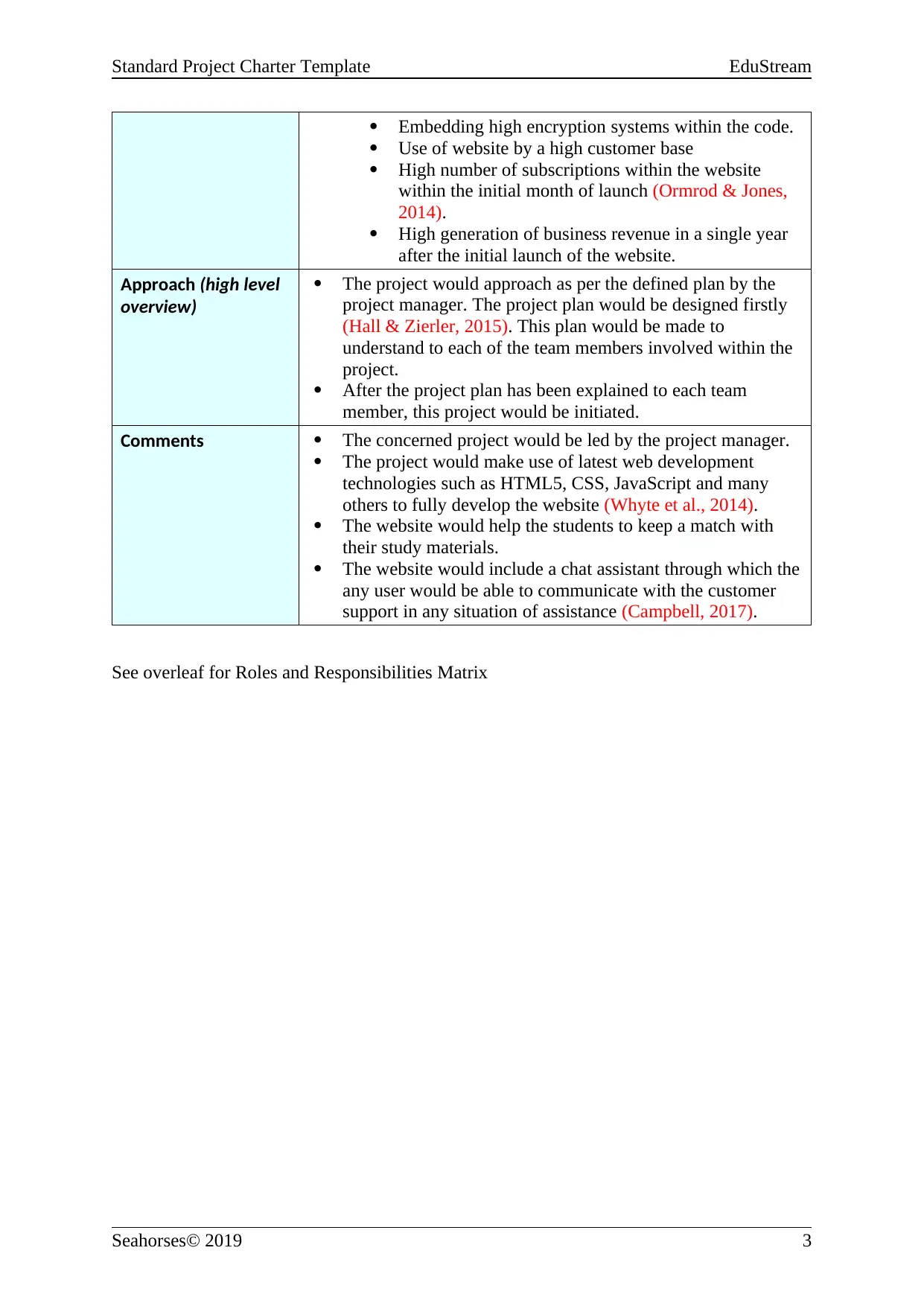
Standard Project Charter Template EduStream
Embedding high encryption systems within the code.
Use of website by a high customer base
High number of subscriptions within the website
within the initial month of launch (Ormrod & Jones,
2014).
High generation of business revenue in a single year
after the initial launch of the website.
Approach (high level
overview)
The project would approach as per the defined plan by the
project manager. The project plan would be designed firstly
(Hall & Zierler, 2015). This plan would be made to
understand to each of the team members involved within the
project.
After the project plan has been explained to each team
member, this project would be initiated.
Comments The concerned project would be led by the project manager.
The project would make use of latest web development
technologies such as HTML5, CSS, JavaScript and many
others to fully develop the website (Whyte et al., 2014).
The website would help the students to keep a match with
their study materials.
The website would include a chat assistant through which the
any user would be able to communicate with the customer
support in any situation of assistance (Campbell, 2017).
See overleaf for Roles and Responsibilities Matrix
Seahorses© 2019 3
Embedding high encryption systems within the code.
Use of website by a high customer base
High number of subscriptions within the website
within the initial month of launch (Ormrod & Jones,
2014).
High generation of business revenue in a single year
after the initial launch of the website.
Approach (high level
overview)
The project would approach as per the defined plan by the
project manager. The project plan would be designed firstly
(Hall & Zierler, 2015). This plan would be made to
understand to each of the team members involved within the
project.
After the project plan has been explained to each team
member, this project would be initiated.
Comments The concerned project would be led by the project manager.
The project would make use of latest web development
technologies such as HTML5, CSS, JavaScript and many
others to fully develop the website (Whyte et al., 2014).
The website would help the students to keep a match with
their study materials.
The website would include a chat assistant through which the
any user would be able to communicate with the customer
support in any situation of assistance (Campbell, 2017).
See overleaf for Roles and Responsibilities Matrix
Seahorses© 2019 3
⊘ This is a preview!⊘
Do you want full access?
Subscribe today to unlock all pages.

Trusted by 1+ million students worldwide
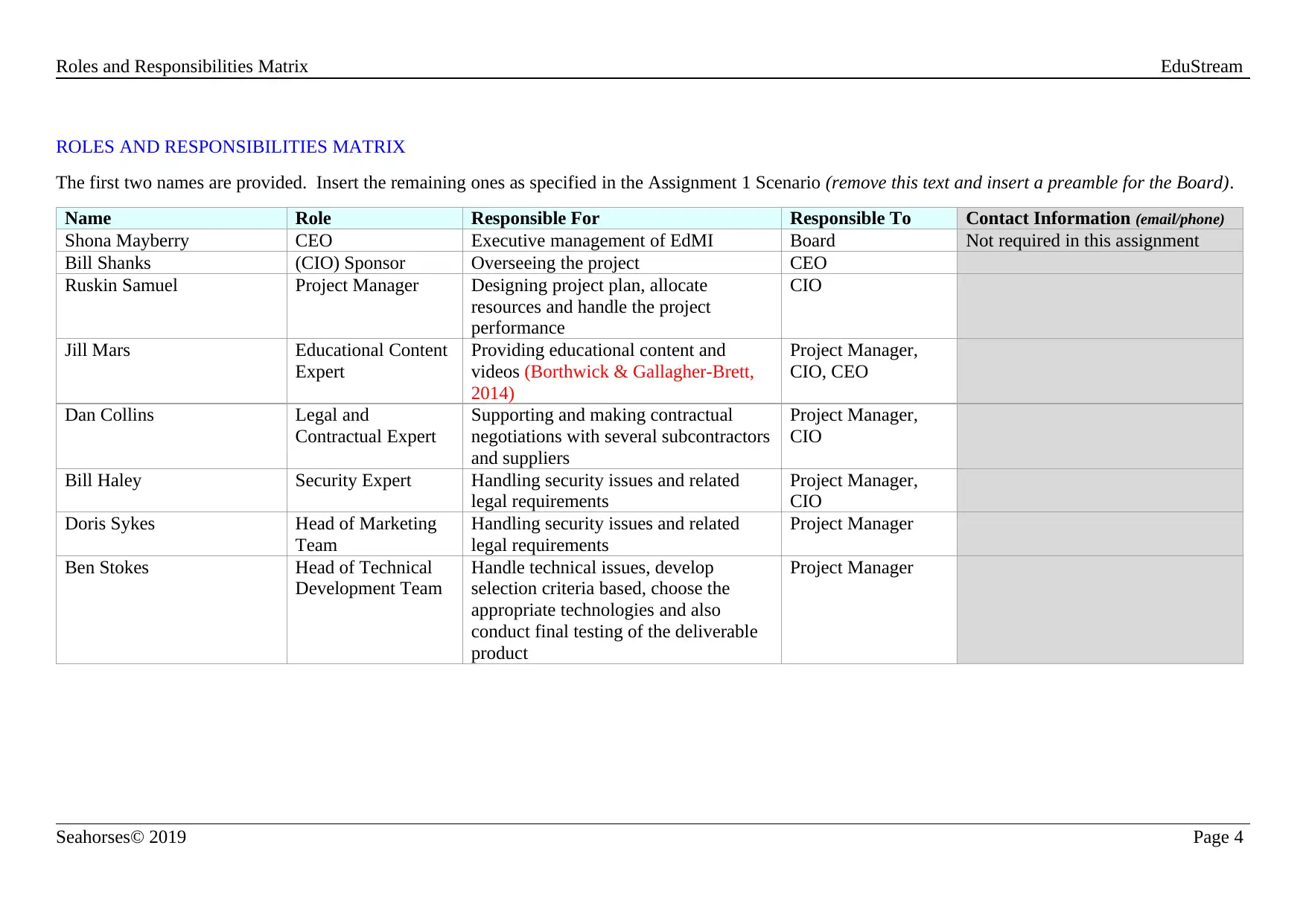
Roles and Responsibilities Matrix EduStream
ROLES AND RESPONSIBILITIES MATRIX
The first two names are provided. Insert the remaining ones as specified in the Assignment 1 Scenario (remove this text and insert a preamble for the Board).
Name Role Responsible For Responsible To Contact Information (email/phone)
Shona Mayberry CEO Executive management of EdMI Board Not required in this assignment
Bill Shanks (CIO) Sponsor Overseeing the project CEO
Ruskin Samuel Project Manager Designing project plan, allocate
resources and handle the project
performance
CIO
Jill Mars Educational Content
Expert
Providing educational content and
videos (Borthwick & Gallagher-Brett,
2014)
Project Manager,
CIO, CEO
Dan Collins Legal and
Contractual Expert
Supporting and making contractual
negotiations with several subcontractors
and suppliers
Project Manager,
CIO
Bill Haley Security Expert Handling security issues and related
legal requirements
Project Manager,
CIO
Doris Sykes Head of Marketing
Team
Handling security issues and related
legal requirements
Project Manager
Ben Stokes Head of Technical
Development Team
Handle technical issues, develop
selection criteria based, choose the
appropriate technologies and also
conduct final testing of the deliverable
product
Project Manager
Seahorses© 2019 Page 4
ROLES AND RESPONSIBILITIES MATRIX
The first two names are provided. Insert the remaining ones as specified in the Assignment 1 Scenario (remove this text and insert a preamble for the Board).
Name Role Responsible For Responsible To Contact Information (email/phone)
Shona Mayberry CEO Executive management of EdMI Board Not required in this assignment
Bill Shanks (CIO) Sponsor Overseeing the project CEO
Ruskin Samuel Project Manager Designing project plan, allocate
resources and handle the project
performance
CIO
Jill Mars Educational Content
Expert
Providing educational content and
videos (Borthwick & Gallagher-Brett,
2014)
Project Manager,
CIO, CEO
Dan Collins Legal and
Contractual Expert
Supporting and making contractual
negotiations with several subcontractors
and suppliers
Project Manager,
CIO
Bill Haley Security Expert Handling security issues and related
legal requirements
Project Manager,
CIO
Doris Sykes Head of Marketing
Team
Handling security issues and related
legal requirements
Project Manager
Ben Stokes Head of Technical
Development Team
Handle technical issues, develop
selection criteria based, choose the
appropriate technologies and also
conduct final testing of the deliverable
product
Project Manager
Seahorses© 2019 Page 4
Paraphrase This Document
Need a fresh take? Get an instant paraphrase of this document with our AI Paraphraser
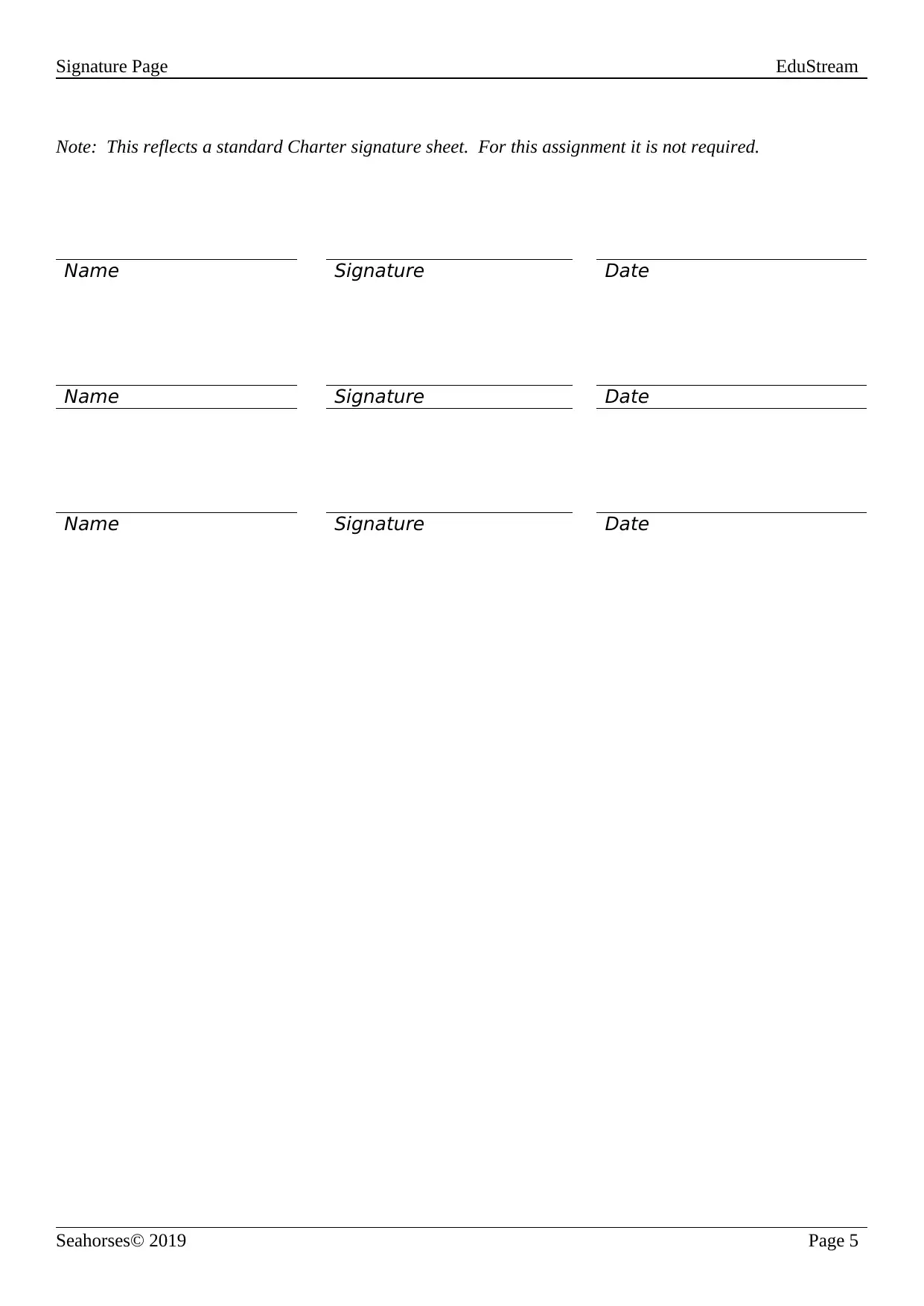
Signature Page EduStream
Note: This reflects a standard Charter signature sheet. For this assignment it is not required.
Name Signature Date
Name Signature Date
Name Signature Date
Seahorses© 2019 Page 5
Note: This reflects a standard Charter signature sheet. For this assignment it is not required.
Name Signature Date
Name Signature Date
Name Signature Date
Seahorses© 2019 Page 5
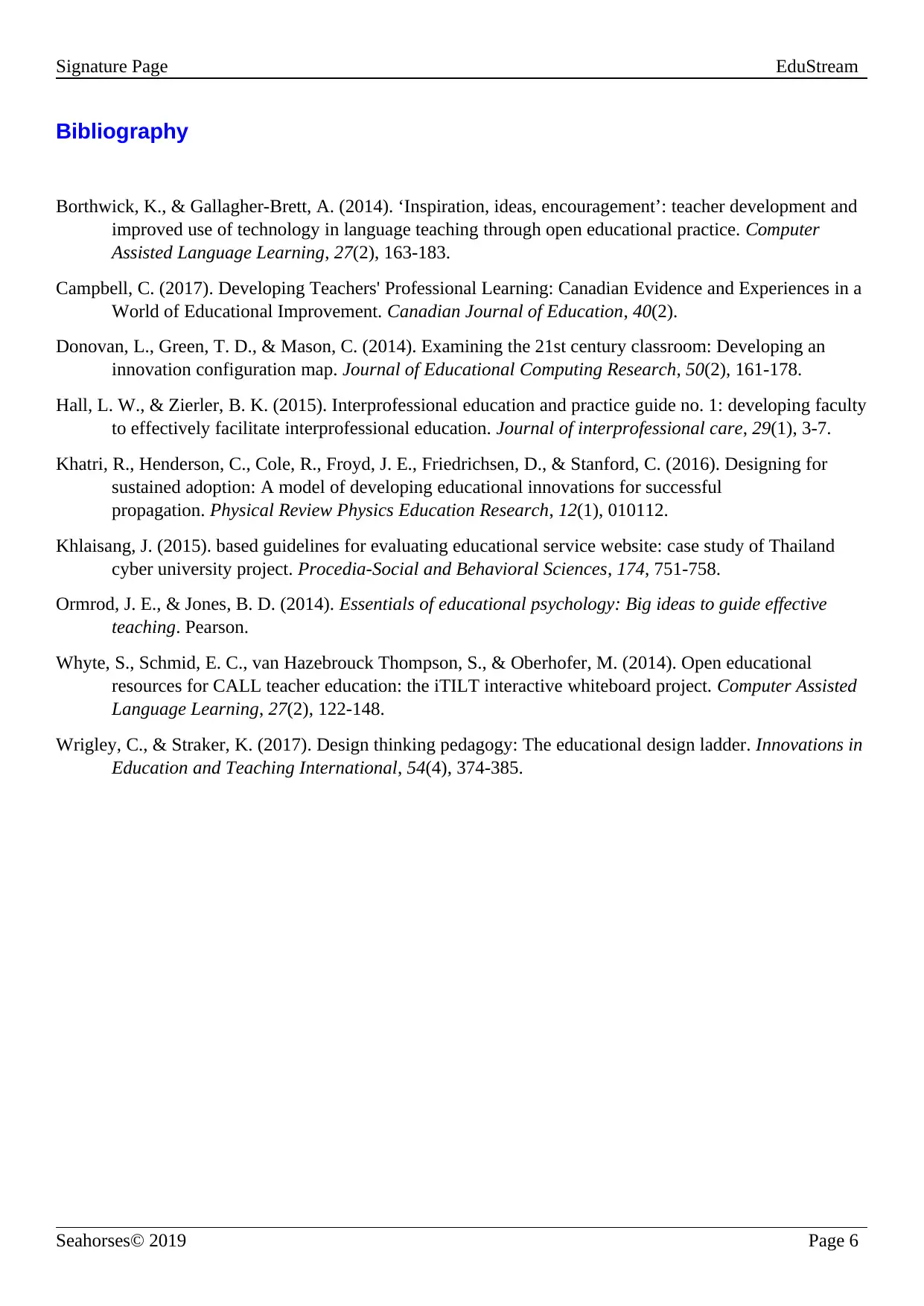
Signature Page EduStream
Bibliography
Borthwick, K., & Gallagher-Brett, A. (2014). ‘Inspiration, ideas, encouragement’: teacher development and
improved use of technology in language teaching through open educational practice. Computer
Assisted Language Learning, 27(2), 163-183.
Campbell, C. (2017). Developing Teachers' Professional Learning: Canadian Evidence and Experiences in a
World of Educational Improvement. Canadian Journal of Education, 40(2).
Donovan, L., Green, T. D., & Mason, C. (2014). Examining the 21st century classroom: Developing an
innovation configuration map. Journal of Educational Computing Research, 50(2), 161-178.
Hall, L. W., & Zierler, B. K. (2015). Interprofessional education and practice guide no. 1: developing faculty
to effectively facilitate interprofessional education. Journal of interprofessional care, 29(1), 3-7.
Khatri, R., Henderson, C., Cole, R., Froyd, J. E., Friedrichsen, D., & Stanford, C. (2016). Designing for
sustained adoption: A model of developing educational innovations for successful
propagation. Physical Review Physics Education Research, 12(1), 010112.
Khlaisang, J. (2015). based guidelines for evaluating educational service website: case study of Thailand
cyber university project. Procedia-Social and Behavioral Sciences, 174, 751-758.
Ormrod, J. E., & Jones, B. D. (2014). Essentials of educational psychology: Big ideas to guide effective
teaching. Pearson.
Whyte, S., Schmid, E. C., van Hazebrouck Thompson, S., & Oberhofer, M. (2014). Open educational
resources for CALL teacher education: the iTILT interactive whiteboard project. Computer Assisted
Language Learning, 27(2), 122-148.
Wrigley, C., & Straker, K. (2017). Design thinking pedagogy: The educational design ladder. Innovations in
Education and Teaching International, 54(4), 374-385.
Seahorses© 2019 Page 6
Bibliography
Borthwick, K., & Gallagher-Brett, A. (2014). ‘Inspiration, ideas, encouragement’: teacher development and
improved use of technology in language teaching through open educational practice. Computer
Assisted Language Learning, 27(2), 163-183.
Campbell, C. (2017). Developing Teachers' Professional Learning: Canadian Evidence and Experiences in a
World of Educational Improvement. Canadian Journal of Education, 40(2).
Donovan, L., Green, T. D., & Mason, C. (2014). Examining the 21st century classroom: Developing an
innovation configuration map. Journal of Educational Computing Research, 50(2), 161-178.
Hall, L. W., & Zierler, B. K. (2015). Interprofessional education and practice guide no. 1: developing faculty
to effectively facilitate interprofessional education. Journal of interprofessional care, 29(1), 3-7.
Khatri, R., Henderson, C., Cole, R., Froyd, J. E., Friedrichsen, D., & Stanford, C. (2016). Designing for
sustained adoption: A model of developing educational innovations for successful
propagation. Physical Review Physics Education Research, 12(1), 010112.
Khlaisang, J. (2015). based guidelines for evaluating educational service website: case study of Thailand
cyber university project. Procedia-Social and Behavioral Sciences, 174, 751-758.
Ormrod, J. E., & Jones, B. D. (2014). Essentials of educational psychology: Big ideas to guide effective
teaching. Pearson.
Whyte, S., Schmid, E. C., van Hazebrouck Thompson, S., & Oberhofer, M. (2014). Open educational
resources for CALL teacher education: the iTILT interactive whiteboard project. Computer Assisted
Language Learning, 27(2), 122-148.
Wrigley, C., & Straker, K. (2017). Design thinking pedagogy: The educational design ladder. Innovations in
Education and Teaching International, 54(4), 374-385.
Seahorses© 2019 Page 6
⊘ This is a preview!⊘
Do you want full access?
Subscribe today to unlock all pages.

Trusted by 1+ million students worldwide
1 out of 6
Related Documents
Your All-in-One AI-Powered Toolkit for Academic Success.
+13062052269
info@desklib.com
Available 24*7 on WhatsApp / Email
![[object Object]](/_next/static/media/star-bottom.7253800d.svg)
Unlock your academic potential
Copyright © 2020–2025 A2Z Services. All Rights Reserved. Developed and managed by ZUCOL.



